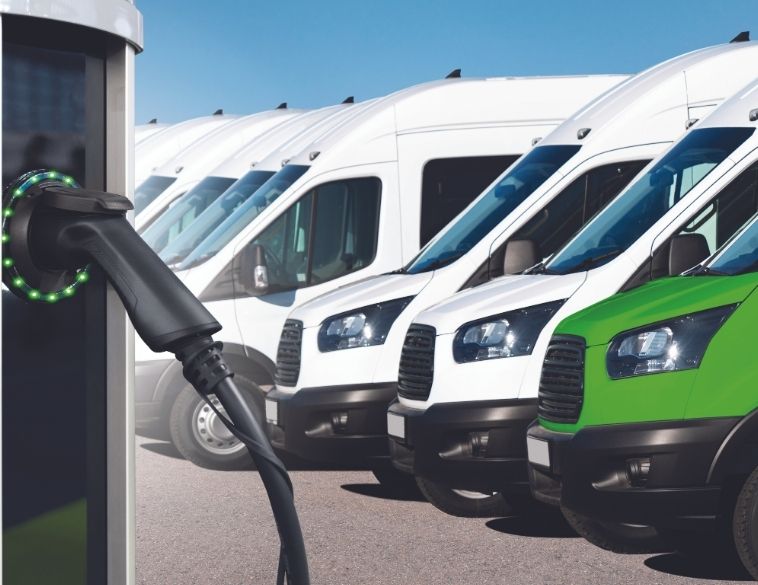Sustainable Fleet Technology Webinar looks at the options available.
Battery Electric Vehicles (BEVs) have been gaining a lot of attention in the fleet management space over the last several years. Yet often, the topic generates more questions than answers.
While there is no denying that BEVs have a place for certain applications, such as last-mile delivery, and other short-haul operations where frequent starting and stopping is required, they don’t suit every fleet application.
When looking at alternative fuel sources, hydrogen has long been considered a viable option. It’s hugely abundant and has the highest energy content by weight of any chemical fuel, plus, when combined with fuel cells emits no emissions, just ionized water.
Further benefits
Additional benefits include much faster refuel times compared with electric vehicles, no reliance on energy grid connections and quiet operations (there are no moving parts in a hydrogen fuel cell). Plus, given that fuel cell technology has advanced significantly in the last 15 years as well as the realization of green hydrogen (created using renewables and water via electrolysis) finally becoming truly cost-competitive, there are a lot of advantages.
Yet challenges still remain, among them infrastructure, which is still a significant hurdle for any kind of widespread adoption.
To help understand what the options are for fleets when it comes to hydrogen, NAFA, in conjunction with NC State University, hosted a webinar entitled Hydrogen Applications for Transportation—as part of the Sustainable Fleet Technology series of webinars.
Hosted by Rick Sapienza, Director, Industry Partnerships, NC Clean Energy Technology Centre at NC State, the webinar featured a number of keynote speakers and specialists, including Ophir Samson, Director of Business Development, HYDROTEC Fuel Cells at General Motors; Robert Mount, Founder and President/CEO at Renewable Innovations; Mark Finnicum, Chief Operations Officer at Stark Area Regional Transit Authority (SARTA), as well as Christopher Cannon, Director of Environmental Management and Chief Sustainability Officer at the Port of Los Angeles.
Significant factors
Ophir Samson explained that three significant factors, namely global net-zero climate goals, advancing technology/lower costs and growing government support are driving interest in utilizing hydrogen as a sustainable fuel source.
Samson noted that due to its very high energy density by weight, hydrogen is a very good choice for applications where weight constraints are a primary concern, such as transportation. When it comes to battery electric versus hydrogen propulsion systems, a big disadvantage of the former is the size and weight of the battery packs required for moving heavier loads. With hydrogen, there are none of these weight factors, meaning for heavy vehicles, such as Class 8 tractor-trailers, hydrogen is far more viable than battery-electric power. Charging duration is also a key factor. Samson explained that it takes between 5-20 minutes to refill a commercial truck with hydrogen compared to a minimum of 45 minutes to charge up the battery in a comparable BEV vehicle. Unlike batteries, performance isn’t impacted by variations in temperature meaning in cold climates like Canada, there will be no reduction in range or performance during winter driving conditions—again, an advantage for commercial fleets.
Nevertheless, there are challenges. Samson highlighted that despite its high energy density by weight, hydrogen has a low density by volume, which means both storing and transporting it is a challenge. Hydrogen requires much greater storage volumes than diesel and in liquid form it must be kept at – 253°F (-158°C). Green hydrogen is also significantly more expensive than diesel and compared to a battery electric vehicle, wheel-to-wheel efficiency is lower. Additionally, there are still major infrastructure challenges to adopting hydrogen for widespread vehicle use, though some jurisdictions (notably California) have been steadily expanding their hydrogen fueling and storing facilities.
OEM developments
As for the automakers, certainly in General Motors’ case [as Samson referenced], there’s been research regarding hydrogen fuel cell technology dating back to the early 1960s, from equipping NASA lunar modules to developing fuel cell passenger cars, vans and light trucks, large over the road trucks and even locomotives. Some of GM’s non-automotive applications for fuel cell technology today include auxiliary power units (APUs) for commercial aircraft, large and small stationary power units, mobile power units and Gen2 powercubes (used for controlling cooling systems etc.).
In terms of automotive technology, Samson noted that GM has been significantly advancing its Hydrotec fuel cell technology, with major improvements in both power density and weight reduction. Additionally, GM has partnered with Honda in a joint-venture agreement to mass-manufacture fuel cells at a facility in Brownstone, Michigan. This partnership leverages proprietary strengths in membrane electrode technology, as well as manufacturing fuel cell stack assemblies. Although fuel cell technology from a vehicle adoption standpoint still isn’t mainstream, investments like these on the OEM side indicate that it will significantly increase this decade and beyond.
Moving onto the infrastructure part, Robert Mount from Renewable Innovations, highlighted actual hydrogen solutions currently in play. Mount said that while there has been a huge emphasis on expanding EV charging across North America, certainly in the U.S., the electrical grid remains fragmented, with a patchwork of operators, who often, have competing interests. As a result, it’s currently very difficult to build long-distance power lines needed for a truly national wind and solar infrastructure, which itself is often inconsistent and unreliable as a significant energy source.
Innovative solutions
Renewable Innovations offers a range of alternative fuel infrastructure solutions for automotive and commercial vehicle fleets. These include a Transport Refueler (Minimum 1000kg H2) that’s fuel cell powered with onboard compression and chilling operation, as well as a range of different refuelling pressures. It fills a significant void in the market related to not only transporting hydrogen but also refilling storage facilities (think tanker trucks but with hydrogen).
Renewable Innovations also offers Mobile Power Generators and Fuel Cell Backup Power units designed for buildings and infrastructure projects as well as mobile, fuel cell-powered EV Rapid Chargers that can be deployed at gas stations and convenience stores to charge vehicles at these locations.
Mount showed the audience a video about Renewable’s recent U.S. East Coast trip where a travelling roadshow went to different locations to demonstrate the value and validity of hydrogen fuel cell technology, including the fact that as a pure element, hydrogen doesn’t degrade over time, unlike gasoline or diesel.
As an abundant substance, with no atmospheric pollution, plus a high energy density from a number of standpoints—hydrogen does indeed appear a truly viable clean energy alternative to diesel fuel, particularly for larger vehicles like tractor-trailers, garbage trucks and off-road equipment.
Mount also provided an overview of Renewable Innovation’s Complete Green Energy Ecosystem, which includes 2400kg of Hydrogen storage via mobile trailers, hydrogen generation and compression station and 1 to 1.5 Megawatt charging for microgrids, with both 400 kW Rapid Charging and 35/700 BAR hydrogen dispensing onsite for both EV and fuel cell vehicles.
Industry-first
While still in the development stages at the time of the webinar, Mount said it will be the first of its kind and an industry first once it is all put together. He also emphasized that hydrogen fuel cell technology can not only be used to power H2 vehicles themselves, but also for generating energy to power EVs, buildings, data centres, whole communities, and other uses.
Mark Finnicum from SARTA, which is a regional transit authority located in Stark County, in northeastern Ohio that provides approximately 2.2 million journeys per year, said that the once almost exclusively diesel-powered fleet is now dominated by compressed natural gas, along with 19 hydrogen fuel cell electric buses and vans. “We only have four diesel vehicles left in service,” said Finnicum.
SARTA’s mission statement is defined as a commitment to “enhancing the quality of life for our community by providing efficient, affordable and sustainable mobility options for Stark County.”
While this midwestern county might not seem an obvious location for a completely renewable energy vehicle fleet, the opportunity came by chance. Originally declined by the American Fuel Cell Bus program, SARTA later received grants that had previously been allocated to Cleveland and Chicago but were not used. Today, it has the fifth-largest hydrogen fleet of vehicles in the U.S. and the second-biggest located outside the state of California.
Operationally, Finnicum said that agencies need a battery electric or hydrogen fuel cell vehicle that can be used in the same way as a diesel or CNG vehicle is today. He noted that being based in northeastern Ohio, where winter is a factor, parasitic load factors do impact hydrogen fuel cell vehicle operation. SARTA’s first hydrogen buses had a range of about 200 miles (320 km) and during the winter it declined by approximately 10 percent due to parasitic load (heating requirements for passengers etc.).
Today, nearly a decade later, SARTA’s newest buses boast a 230-mile (368 km) range with a smaller fuel cell and an additional 10 kg of hydrogen. The fleet has also modified its Ford e-Transit cutaway vans from pure battery electrics to fuel cells, extending the range from 100 miles (160 km) to 250 (400 km) and even 300 miles (480 km). By taking a leadership role in working with engineers and vendors to make these improvements and ensure their fleet of alternative fuel vehicles are viable in all weather conditions, the results have been clearly demonstrated.
Growing pains
From an infrastructure standpoint, Finnicum noted that employing hydrogen fuel cells successfully will result in growing pains—in SARTA’s case, a big one has been relocating employee parking to accommodate the filling stations for the bus fleet. He said it takes about 20 minutes to fill a hydrogen bus that can travel over 200 miles, but often the biggest challenge is educating your employees, members of the community and first responders, plus state and federal politicians on hydrogen fuel cells and the reality of using them commercially in vehicle fleets.
Christopher Cannon noted that the Port of Los Angeles has developed its own Clean Air Action Plan—a document that outlines a series of goals and strategies for reducing air emissions from operations at the Port which includes ships, trains, trucks and other vehicles such as hovercraft and cranes/loaders.
Included within this roadmap are plans to have all terminal equipment and on-road trucks to be zero-emission by 2035 and reduce greenhouse gas emissions to 40 and 80% below 1990 levels by 2030 and 2050.
Like other emissions reduction goals in the Golden State, these are very aggressive numbers, though Cannon acknowledged they are goals and the way in which the Port of Los Angeles gets there, likely won’t rely on a single fuel source—and the heavier the duty cycle and the longer the distance required [such as long-haul trucks], the more hydrogen makes sense for those kinds of applications. “We are very excited about the opportunities and potential of using hydrogen,” said Cannon, adding that “we are recognizing concerns about the perception of hydrogen, as well as safety considerations in storing it, fueling it and using it to power vehicles that operate within the Port of LA’s jurisdiction.”
Cannon noted that a pilot project utilizing Kenworth T-680 FCEV Class 8 conventional trucks equipped with Toyota fuel cells has proved very successful and could pave the way for regional-haul transportation of goods from the port to distribution points in California. The trucks themselves are now being offered as commercially available to fleet operators—a definite sign that hydrogen as a viable alternative fuel source is really starting to gain traction amongst fleets.






 MONTRÉAL
MONTRÉAL Full time
Full time


